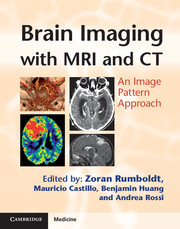Book contents
- Frontmatter
- Contents
- List of contributors
- List of abbreviations
- Preface
- Section 1 Bilateral Predominantly Symmetric Abnormalities
- 1 Hepatic Encephalopathy
- 2 Neurofibromatosis Type 1 – UBOs
- 3 Carbon Monoxide Intoxication
- 4 Pantothenate Kinase-Associated Neurodegeneration (Hallervorden–Spatz Syndrome)
- 5 Methanol Intoxication
- 6 Wilson Disease 12
- 7 Hypoxic Ischemic Encephalopathy in Term Neonates
- 8 Cryptococcosis
- 9 Gangliosidosis GM2
- 10 Leigh Disease
- 11 Deep Cerebral Vein Thrombosis (DCVT)
- 12 Creutzfeldt-Jakob Disease (CJD)
- 13 Global Cerebral Anoxia in Mature Brain
- 14 Wernicke Encephalopathy
- 15 Amyotrophic Lateral Sclerosis
- 16 Glutaric Aciduria Type 1
- 17 Subcortical Band Heterotopia
- 18 Bilateral Perisylvian Polymicrogyria (BPP)
- 19 Lissencephaly
- 20 Herpes Simplex Encephalitis
- 21 Limbic Encephalitis
- 22 CADASIL (Cerebral Autosomal Dominant Arteriopathy with Subcortical Infarcts and Leukoencephalopathy)
- 23 Megalencephalic Leukoencephalopathy with Subcortical Cysts
- 24 Canavan Disease
- 25 HIV Encephalopathy
- 26 Radiation- and Chemotherapy-Induced Leukoencephalopathy
- 27 Leukoaraiosis (Microangiopathy)
- 28 Periventricular Edema in Acute Hydrocephalus
- 29 Hypoglycemia
- 30 X-Linked Adrenoleukodystrophy (X-ALD)
- 31 Periventricular Leukomalacia (PVL)
- 32 Posterior Reversible Encephalopathy Syndrome (PRES, Hypertensive Encephalopathy)
- 33 Alexander Disease
- 34 Metachromatic Leukodystrophy
- 35 Neurodegenerative Langerhans Cell Histiocytosis (ND-LCH)
- 36 Remote Cerebellar Hemorrhage
- 37 Spontaneous Intracranial Hypotension
- Section 2 Sellar, Perisellar and Midline Lesions
- Section 3 Parenchymal Defects or Abnormal Volume
- Section 4 Abnormalities Without Significant Mass Effect
- Section 5 Primarily Extra-Axial Focal Space-Occupying Lesions
- Section 6 Primarily Intra-Axial Masses
- Section 7 Intracranial Calcifications
- Index
- References
36 - Remote Cerebellar Hemorrhage
from Section 1 - Bilateral Predominantly Symmetric Abnormalities
Published online by Cambridge University Press: 05 August 2013
- Frontmatter
- Contents
- List of contributors
- List of abbreviations
- Preface
- Section 1 Bilateral Predominantly Symmetric Abnormalities
- 1 Hepatic Encephalopathy
- 2 Neurofibromatosis Type 1 – UBOs
- 3 Carbon Monoxide Intoxication
- 4 Pantothenate Kinase-Associated Neurodegeneration (Hallervorden–Spatz Syndrome)
- 5 Methanol Intoxication
- 6 Wilson Disease 12
- 7 Hypoxic Ischemic Encephalopathy in Term Neonates
- 8 Cryptococcosis
- 9 Gangliosidosis GM2
- 10 Leigh Disease
- 11 Deep Cerebral Vein Thrombosis (DCVT)
- 12 Creutzfeldt-Jakob Disease (CJD)
- 13 Global Cerebral Anoxia in Mature Brain
- 14 Wernicke Encephalopathy
- 15 Amyotrophic Lateral Sclerosis
- 16 Glutaric Aciduria Type 1
- 17 Subcortical Band Heterotopia
- 18 Bilateral Perisylvian Polymicrogyria (BPP)
- 19 Lissencephaly
- 20 Herpes Simplex Encephalitis
- 21 Limbic Encephalitis
- 22 CADASIL (Cerebral Autosomal Dominant Arteriopathy with Subcortical Infarcts and Leukoencephalopathy)
- 23 Megalencephalic Leukoencephalopathy with Subcortical Cysts
- 24 Canavan Disease
- 25 HIV Encephalopathy
- 26 Radiation- and Chemotherapy-Induced Leukoencephalopathy
- 27 Leukoaraiosis (Microangiopathy)
- 28 Periventricular Edema in Acute Hydrocephalus
- 29 Hypoglycemia
- 30 X-Linked Adrenoleukodystrophy (X-ALD)
- 31 Periventricular Leukomalacia (PVL)
- 32 Posterior Reversible Encephalopathy Syndrome (PRES, Hypertensive Encephalopathy)
- 33 Alexander Disease
- 34 Metachromatic Leukodystrophy
- 35 Neurodegenerative Langerhans Cell Histiocytosis (ND-LCH)
- 36 Remote Cerebellar Hemorrhage
- 37 Spontaneous Intracranial Hypotension
- Section 2 Sellar, Perisellar and Midline Lesions
- Section 3 Parenchymal Defects or Abnormal Volume
- Section 4 Abnormalities Without Significant Mass Effect
- Section 5 Primarily Extra-Axial Focal Space-Occupying Lesions
- Section 6 Primarily Intra-Axial Masses
- Section 7 Intracranial Calcifications
- Index
- References
Summary
Specific Imaging Findings
Remote cerebellar hemorrhage (RCH) typically occurs bilaterally along the superior aspect of the cerebellum following the cerebellar folia in a linear arched pattern that has been termed “zebra sign”. A recent RCH is seen as multiple linear hyperdensities on non-enhanced CT images. The same striped pattern is found on MRI, and it follows the signal intensity characteristics that vary according to the age of hemorrhage. The susceptibility effect from blood products is seen as signal loss on T2* MR sequences, gradient echo (GRE) or susceptibility-weighted images (SWI). Unilateral RCH is infrequent. Vascular studies, CTA, MRA, or DSA, reveal intact appearance of the venous sinuses and other vascular structures, without signs of thrombosis.
Pertinent Clinical Information
RCH is a rare complication of cranial and spinal surgeries that include opening of the dura. It has been reported following a wide range of procedures, from laminectomies and lumbar CSF drainages to temporal lobectomies, vascular neurosurgery, supratentorial tumor resections, and even single burr hole drainages. The most common symptoms are decreased level of consciousness, headache, nausea, and dizziness. The onset of symptoms is in the range from a few hours to a number of days after the surgical procedure. RCH is frequently benign and self-limited, but it may entail significant morbidity and result in death.
- Type
- Chapter
- Information
- Brain Imaging with MRI and CTAn Image Pattern Approach, pp. 73 - 74Publisher: Cambridge University PressPrint publication year: 2012

